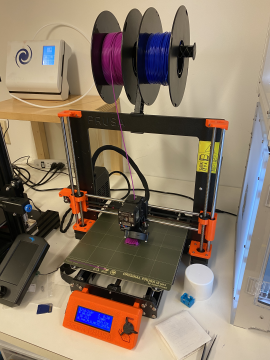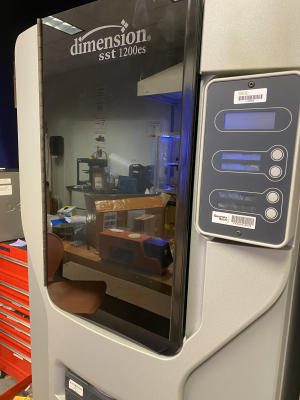Fused Filament Fabrication (FFF): Difference between revisions
No edit summary |
No edit summary |
||
| Line 1: | Line 1: | ||
{| class="infobox" | {| class="infobox" | ||
!| | !| | ||
! style="font-size:135%;text-align:center;" |Ultimaker 2+ (FFF) | ! style="font-size:135%;text-align:center;" |Ultimaker 2+ (FFF) [https://sites.gatech.edu/mse-mill/sop/ultimaker/ [SOP<nowiki>]</nowiki>] | ||
! style="font-size:135%;text-align:center;" |Hyrel System 30M (FFF) | ! style="font-size:135%;text-align:center;" |Hyrel System 30M (FFF) [https://sites.gatech.edu/mse-mill/sop/hyrel/ [SOP<nowiki>]</nowiki>] | ||
! style="font-size:135%;text-align:center;" |Prusa i3 MK3S (FFF) | ! style="font-size:135%;text-align:center;" |Prusa i3 MK3S (FFF) [https://sites.gatech.edu/mse-mill/sop/prusa-i3/ [SOP<nowiki>]</nowiki>] | ||
|- | |- | ||
| ||[[File:Ultimaker-052621.png|center|270px]]||[[File:Hyrel-052621.png|center|270px]]||[[File:PrusaPrinter-052621.png|center|270px]] | | ||[[File:Ultimaker-052621.png|center|270px]]||[[File:Hyrel-052621.png|center|270px]]||[[File:PrusaPrinter-052621.png|center|270px]] | ||
| Line 49: | Line 49: | ||
{| class="infobox" | {| class="infobox" | ||
!| | !| | ||
! style="font-size:135%;text-align:center;" |Stratasys Dimension sst 1200es (FDM) | ! style="font-size:135%;text-align:center;" |Stratasys Dimension sst 1200es (FDM) [https://sites.gatech.edu/mse-mill/sop/dimension/ [SOP<nowiki>]</nowiki>] | ||
|- | |- | ||
| ||[[File:Dimension-062721.png|center|300px]] | | ||[[File:Dimension-062721.png|center|300px]] | ||
Latest revision as of 23:10, 5 October 2021
| Ultimaker 2+ (FFF) [SOP] | Hyrel System 30M (FFF) [SOP] | Prusa i3 MK3S (FFF) [SOP] | |
|---|---|---|---|
| Slicer Software: | Ultimaker Cura | Slic3r (built-in) | PrusaSlicer |
| Build Volume: | 22.3(L) x 22.3(W) x 20.5(H) cm | 22.5(L) x 20(W) x 20(H) cm | 25(L) x 21(W) x 21(H) cm |
| Extruders: | BondTech Dual Drive | ? | BondTech gears with E3D V6 hotend (max. 285°C) |
| Supported Filament: | PLA, ABS, CPE, CPE+, TPU, PC, PP | PLA, ABS, PEEK | PLA, PETG, ASA, ABS, PC, CPE, PVA/BVOH, PVB, HIPS, PP, Flex, nGen, Nylon, Carbon filled, Woodfill |
| Filament Diameter: | 2.85mm | 1.75mm | 1.75mm |
| Layer Resolution: | 0.06-0.15 mm | ? | 0.05 - 0.35 mm |
| Extrusion Speed: | up to 8 mm3/s | ? | ? |
| XY Precision: | 12.5 µm | 5 µm | ? |
| Z Precision: | 5 µm | 1 µm | ? |
Introduction
Fused Filament Fabrication (FFF) is a technology that enables the creation of prototypes in short timeframes by moving an extrusion nozzle horizontally and vertically[1]. It is also known as fused deposition modeling (FDM) which is trademarked by Stratasys. These machines are all built with a heated nozzle that extrudes thermoplastic filaments onto a build plate where the cross-sectional layers are applied individually to create the 3D object. The differences in the printers are the types of nozzles, the maximum heat of the nozzles and the bed, the size of the build plate, the size of filament allowed, and whether the printer is enclosed or not. These differences will impact the kind of material that can be printed and the size of the object as well as the detailing of the object. FFF 3D printers use thermoplastic filaments to build up layers of 3D objects by cooling the plastic so that it forms bonds with the previous layer. FFF printing has a larger variety of materials and colors and blends and requires little to no cleaning with lower material and machining costs.
Principle
The process for FFF printing starts with a digital design being uploaded to the computer on the printer. The computer then translates the object from the design into coordinates for the base and nozzle to follow. The nozzle is heated which melts the filaments then the nozzle extrudes the melted plastic onto the base plate layer by layer. As the nozzle moves, the plastic solidifies to form the object in 3 dimensions. The larger and the more complicated the object, the longer the process takes. The detail on finished prints is limited by the sizing of the nozzle, but it does not produce the finest of details. FFF printers work with the nozzle above the bed plate. Some printers have the nozzle move in both x and y directions (Ultimaker); some nozzles move in x and z directions (Prusa), and some move in the y direction only (Hyrel). Whichever direction the nozzle does not move, the bed moves. The filament needs to bond to a previous layer in order for the layers to be properly formed. This means that if the angle is greater than 45 degrees, support material is needed to build the layers. This computer knows to generate the supports for the object, and support material is removable after the print is finished. At the end of the process, the object can be removed from the build plate then the supports should be removed and the print is done.
Why Choose FDM/FFF 3D Printing?
Material Variety
FFF printing has a wide variety of materials available. There are composite blends and flexible materials along with many more options. Some materials include PLA, ABS, PETG, PEI, PEEK, TPU, HIPS, nGEN, Nylon, POM, Carbon Fiber PLA, and wood composites. These materials can also be used simultaneously which offers a wide range of flexibility in the process. There have also been an abundance of colors created which increases the variety in prints[2].
Prototyping
FFF printed prototypes are generally ideal because they can undergo heat, chemical stress, and mechanical stress with little to no problems. The printing process also produces detailed prototypes that can be used to ensure fit and form for the real parts.
Low Machine and Equipment Costs
FFF printing is cheaper than other 3D printing methods. The materials used are less costly than other printers along with the printers being more cost efficient. The basic printers can cost a few hundred dollars while the better printers can cost anywhere from $2,000-$8,000.
No cleaning
FFF processing creates a product that is ready for use immediately after print, unless there are supports which need to be removed before use. This makes the method efficient and less messy.
| Stratasys Dimension sst 1200es (FDM) [SOP] | |
|---|---|
| Build Volume: | 10" x 10" x 12" |
| Filament Types: | ABS with PLA supports |
References
- ↑ FDM 3D printing - Fused Deposition Modeling also know as FFF. Tractus3D. (2020, July 16). https://tractus3d.com/knowledge/learn-3d-printing/fdm-3d-printing/.
- ↑ FDM vs. SLA: Compare the Two Most Popular Types of 3D Printers. Formlabs. (n.d.). https://formlabs.com/blog/fdm-vs-sla-compare-types-of-3d-printers/.





